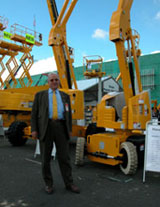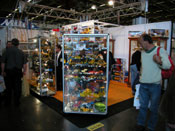Recent economic fallout in equipment markets has drifted from North America into Europe, according to bargain hunters and equipment manufacturer representatives who made a trek to Paris for Intermat 2003, touted as the world's largest heavy equipment show of the year.
 |
| THIN CROWD: Weeklong Metro strikes leave many attendees stuck in hotel rooms. |
The May 13-17, 320,000-square-meter exhibition got off to a quieter start than usual, as corporate financial concerns, a pervasive glut of new and used machinery on the market, continued international conflict and the SARS epidemic forced many firms to stay at home. Likewise, Intermat officials lost key speakers for a conference on construction in China, forcing cancellation of the talk. And as if adding insult to injury, Parisian Metro workers demanding a better pension plan coordinated city-wide mass-transit strikes throughout the week, leaving thousands of show attendees with few transportation options to and from the convention center located several miles outside the city.
 |
| Haulotte's Saubot braces for modest sales decline. |
Those who did attend seemed to agree that low demand and appealing interest rates make it a buyer's market at the moment. "But even when interest rates are low, sometimes it is not enough," says Pierre Saubot, chairman and CEO of aerial work platform producer Pinguely-Haulotte, LHorme, France. Although the company displayed more than 20 new machines at its stand, Saubot still expects the European equipment market to slip 10% this year, with an overall 5-10% drop in global sales in total.
Furthermore, foreign politics have hurt French producers efforts in North America prior to and immediately following U.S. military campaigns in Iraq. "We recently had one customer send in a fax saying he would not buy a French machine. He later called back and apologized," says Daniel Danart, president of Haulottes U.S. distribution center in Baltimore, Md. However, despite these displays of political friction, Saubot says he believes this is a short-term problem.
In terms of domestic distribution, U.S. manufacturers have gained a slight advantage over importers from current exchange rates, with the U.S. dollar falling as much as 30% against the Euro since January 2002, says Leigh Sparrow, vice president of global distribution for UpRight Inc. of Madera, Calif.
 |
| Model miniatures are still popular attractions for all types of equipment enthusiasts. |
What's more, big producers with significant market share, such as Caterpillar, Case, Deere and JCB, have made aggressive inroads to expand lines of retail accessories designed to offset low equipment demand and increase brand awareness. For example, toy models are still lucrative tradeshow attractions, representing about $120 million in retail sales of Caterpilar-licensed toys. Martijn Knoops, equipment operator for Vlierden, Netherlands-based excavation contractor Swinkels, sums up a contractor's passion for models as such: "I find machines beautiful. So, if you love them big, then you also love them small." Ric McDaniel, Caterpillar program manager responsible for children's products and collectibles, says the retail market now sells about $800 million in CAT-licensed "soft" goods and apparel each year, including model miniatures.
(PHOTOS BY TUDOR HAMPTON FOR ENR)
![]()
